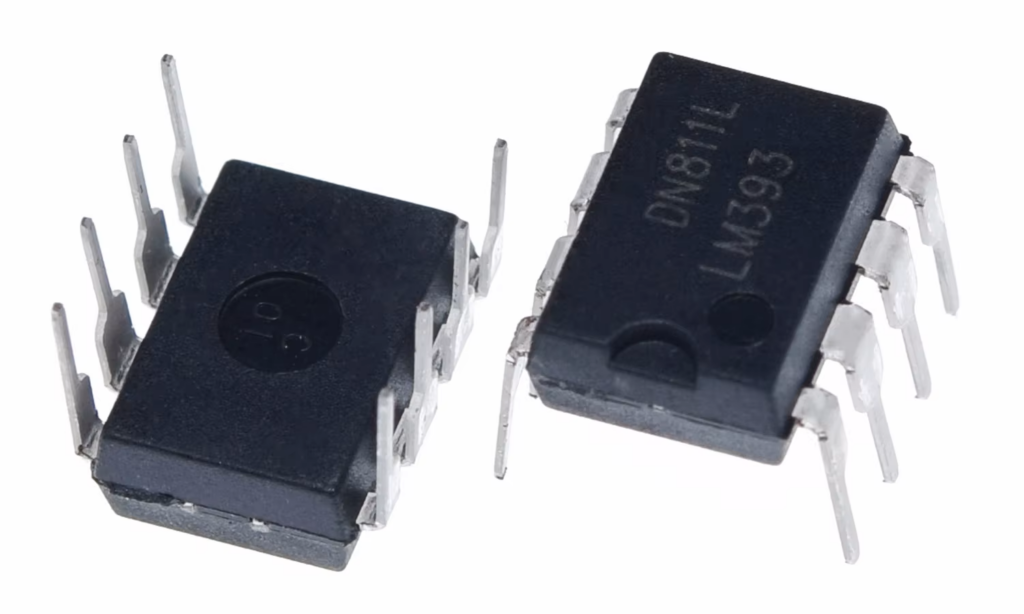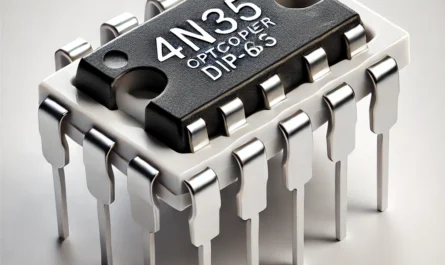The LM393 is a dual voltage comparator that is widely used in sensor circuits, voltage monitoring, signal processing, and microcontroller-based applications. It allows you to compare two voltages and output a digital HIGH or LOW signal based on the comparison.
🔹 1. What is LM393?

- LM393 is a dual comparator, meaning it has two independent voltage comparators inside a single package.
- Unlike an operational amplifier (Op-Amp), it is designed specifically for fast voltage comparison.
- Outputs either HIGH (logic 1) or LOW (logic 0), making it ideal for microcontroller interfacing.
📌 Key Features:
- Dual comparators in one package (can compare two separate voltage pairs).
- Open-collector output (allows interfacing with different voltage levels).
- Low power consumption.
- Can operate from a single power supply (2V – 36V).
- Fast response time (~1.3µs switching speed).
📌 Common Applications:
- Zero-crossing detection (detects when a signal crosses 0V).
- Overvoltage and undervoltage protection.
- Analog-to-digital conversion (ADC) circuits.
- IR sensors, motion detectors.
- Battery level monitoring.
🔹 2. LM393 Pinout & Functions
The LM393 comes in an 8-pin DIP/SOIC package.
| Pin No. | Name | Function |
|---|---|---|
| 1 | OUT1 | Output of Comparator 1 |
| 2 | IN1- | Inverting Input (-) of Comparator 1 |
| 3 | IN1+ | Non-Inverting Input (+) of Comparator 1 |
| 4 | GND | Ground (0V) |
| 5 | IN2+ | Non-Inverting Input (+) of Comparator 2 |
| 6 | IN2- | Inverting Input (-) of Comparator 2 |
| 7 | OUT2 | Output of Comparator 2 |
| 8 | VCC | Power Supply (2V – 36V) |
📌 How it works:
- Each comparator compares two voltages (
IN+andIN-). - If
IN+>IN-, the output is LOW (0V). - If
IN->IN+, the output is HIGH (open-collector, needs a pull-up resistor).
🔹 3. How LM393 Works
- The LM393 outputs a digital HIGH or LOW based on the voltage difference between
IN+andIN-. - Unlike Op-Amps, the output is open-collector, meaning it requires a pull-up resistor to function properly.
📌 Logic Table for LM393 Comparator:
| Condition | Output (OUTx Pin) |
|---|---|
IN+ > IN- | LOW (0V, sinks current) |
IN+ < IN- | HIGH (Needs pull-up resistor to VCC) |
🔹 4. Using LM393 for a Sensor Circuit
🛠 Required Components
- 1x LM393 Comparator
- 1x LDR (Light Dependent Resistor)
- 1x 10kΩ Resistor (Pull-down)
- 1x 100kΩ Resistor (Reference Divider)
- 1x LED + 330Ω Resistor (Output Indicator)
- 1x 5V Power Supply
- Jumper Wires
🛠 Wiring
| LM393 Pin | Connection |
|---|---|
| VCC (Pin 8) | +5V |
| GND (Pin 4) | GND (0V) |
| IN1+ (Pin 3) | LDR voltage divider output |
| IN1- (Pin 2) | Reference voltage (via 100kΩ resistor) |
| OUT1 (Pin 1) | LED + 330Ω Resistor to VCC |
📌 How it works:
- When LDR detects bright light,
IN+voltage increases aboveIN-, and the output goes LOW (LED OFF). - When LDR detects darkness,
IN+drops belowIN-, and the output goes HIGH (LED ON).
🔹 5. Arduino Code for LM393 (Reading Output)
This code reads the output of LM393 and prints the light level.
#define SENSOR_PIN 7 // LM393 output connected to Arduino D7
void setup() {
pinMode(SENSOR_PIN, INPUT);
Serial.begin(9600);
}
void loop() {
int state = digitalRead(SENSOR_PIN);
if (state == LOW) {
Serial.println("Bright Light Detected");
} else {
Serial.println("Darkness Detected");
}
delay(500);
}
📌 What happens?
- When it’s bright, the output is LOW (0V) → The Arduino detects “Bright Light Detected”.
- When it’s dark, the output is HIGH → The Arduino detects “Darkness Detected”.
🔹 6. LM393 for Battery Level Monitoring
📌 Can be used to monitor battery voltage and trigger alerts when voltage drops below a threshold.
✅ Example: Low Battery Indicator
| LM393 Pin | Connection |
|---|---|
| VCC (Pin 8) | Battery Positive |
| GND (Pin 4) | Battery Negative (0V) |
| IN1+ (Pin 3) | Voltage Divider (Battery Voltage Sampling) |
| IN1- (Pin 2) | Fixed Reference Voltage (Zener or Resistor Divider) |
| OUT1 (Pin 1) | Connects to LED or Microcontroller for alert |
📌 If battery voltage drops below threshold, LM393 output goes HIGH, triggering an alert.
🔹 7. Applications of LM393
✅ Light Sensing (LDR Circuits) – Used for automatic street lights.
✅ Zero-Crossing Detection – Detects when AC voltage crosses 0V.
✅ Overvoltage/Undervoltage Protection – Prevents damage to circuits.
✅ DC Motor Speed Monitoring – Used in tachometers.
✅ Touchless IR Sensors – Common in motion detection systems.
🔹 8. LM393 vs Other Comparators
| Feature | LM393 | LM358 (Op-Amp) | LM339 (Quad Comparator) |
|---|---|---|---|
| Number of Comparators | 2 | 2 (Op-Amps, not true comparators) | 4 |
| Operating Voltage | 2V – 36V | 3V – 32V | 2V – 36V |
| Output Type | Open-Collector | Push-Pull | Open-Collector |
| Best For | Logic-level voltage detection | Analog amplification | Multi-channel voltage comparison |
📌 Verdict:
- LM393 is ideal for digital-level voltage comparisons (requires pull-up resistor).
- LM358 is an Op-Amp, better for analog signal amplification.
- LM339 is a quad comparator (similar to LM393 but with four comparators).
🎯 Conclusion
- LM393 is a dual voltage comparator with an open-collector output.
- Used in light sensing, battery monitoring, zero-crossing detection, and voltage protection.
- Requires a pull-up resistor for output.
- Ideal for microcontroller-based applications (low power, fast switching).







